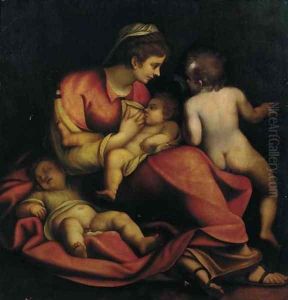Pier Francesco Piola Paintings
Pier Francesco Piola, often known as il Domenichino genovese due to his stylistic resemblance to the Bolognese painter Domenichino, was an Italian Baroque painter of the Genoese school. Born in Genoa in 1613, Piola was part of a family of painters; his father, Domenico Piola, was also a prominent artist in Genoa, and it is under his guidance that Pier Francesco began his artistic training.
Pier Francesco Piola’s early work was heavily influenced by his father and later by the works of other Genoese artists such as Giovanni Benedetto Castiglione and Sinibaldo Scorza. His style, however, gradually evolved, reflecting the influences of both northern Italian painters and the naturalism of Caravaggio. Piola's work was known for its gentle grace and use of soft colors, and he was skilled in creating a sense of harmony in his compositions.
Throughout his career, Piola contributed to the decoration of several churches in Genoa, executing altarpieces and frescoes that displayed his capability in handling both large-scale compositions and more intimate devotional images. His paintings often featured religious themes, imbued with a sense of piety and infused with a Baroque sense of movement and drama.
Pier Francesco Piola’s body of work also includes mythological and allegorical subjects. His ability to blend classical themes with the dynamism of the Baroque style made his work popular among the patrons of his time. Unfortunately, like many artists of the period, much of Piola’s work has been lost over time, and what remains may only partially represent his oeuvre.
Piola died in Genoa in 1670, leaving behind a legacy that would be continued by his descendants. His son, Paolo Gerolamo Piola, and other members of the Piola family workshop would carry on the stylistic traits and artistic tradition established by Pier Francesco, thus perpetuating the Piola artistic lineage well into the 18th century. Despite not being as widely recognized as some of his contemporaries, Piola’s work remains an important part of the Genoese Baroque movement and offers valuable insight into the development of Baroque painting in northern Italy.



